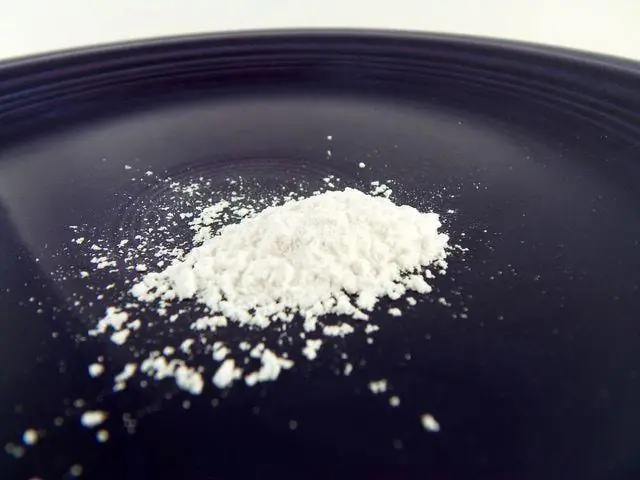
Table of contents:
- Author Bailey Albertson [email protected].
- Public 2024-01-17 22:26.
- Last modified 2025-06-01 07:32.
Potato variety Gala: the secrets of cultivating an early maturing nurse

The Gala potato variety was liked by gardeners due to the mass of its advantages. In particular, it does not require careful maintenance and gives high yields. Also noteworthy is the short ripening period, good taste and dietary properties of root crops.
Content
- 1 History of variety breeding
-
2 Description of Gala potatoes
- 2.1 Video: characteristics of Gala potatoes
- 2.2 Table: advantages and disadvantages of the Gala variety
-
3 Rules for planting potatoes
- 3.1 Choosing a landing site
- 3.2 Site preparation
- 3.3 Preparation of planting material
- 3.4 Planting potatoes
-
4 Crop care
- 4.1 Loosening and hilling
-
4.2 Scheme and timing of watering potatoes
4.2.1 Table: features of watering
- 4.3 Rates and timing of fertilization - table
-
5 Diseases characteristic of Gala potatoes - table
5.1 Typical cultural ailments in the photo
-
6 Table: potato pests
6.1 Photo Gallery: Variety Threatening Parasites
- 7 Collection and storage of crops
- 8 Reviews of gardeners
Breeding history of the variety
Gala potatoes are a young variety bred in the early 2000s. It was developed by German breeders, however, due to its merits, the culture is popular not only in Germany, but also abroad. Since 2008, this potato has been listed in the State Register of the Russian Federation and is recommended for the northern and central regions.

Gala potatoes - early maturing and high-yielding variety
Description of Gala potatoes
Gala belongs to the early maturing varieties. The tubers reach full maturity within 2 months after planting. The bush is moderately spreading, of medium height. Stems are erect, powerful, develop evenly. The ground part has a deep green color. The leaves are large with slight waviness. Corolla white, medium size.

Gala belongs to table varieties with excellent taste.
The tubers are round or oval, covered with a yellowish skin. The average weight of fruits is 100-120 g, they grow in length up to 7-8 cm, in width up to 5 cm. Up to 25 tubers are obtained from the bush. The pulp is light yellow or yellow in color, has a dense fibrous structure.
Gala potatoes contain protein, carotene, vitamin C and potassium, which makes it possible to include tubers in the dietary menu and recommend them for the diet of the elderly. As a result of heat treatment, the structure of root crops does not change, they do not boil and do not darken. The palatability of Gala potatoes was rated quite high - 9 points out of 10. The correct shape of the tubers facilitates their peeling. The variety has good keeping quality.
Video: characteristics of Gala potatoes
Table: advantages and disadvantages of the Gala variety
| Benefits | disadvantages |
| Early ripening | Susceptibility to Rhizoctonia |
| Good storage of tubers | Weak resistance to late blight |
| Unpretentiousness to soil | |
| Suitability of fruits for dietary nutrition | |
| Resistant to golden cyst nematode and root cancer | |
| High commercial qualities | |
| Transport resistance | |
| Ability to tolerate lack of moisture |
Potato planting rules
Potatoes are a crop that is demanding on the composition and fertility of the soil, so the site for planting should be prepared in advance.
Choosing a landing site
A site for potatoes is chosen on a flat, well-lit area. In lowland and swampy areas, the culture does not develop well, therefore, groundwater should lie at a depth of 1.5 m from the surface.

Potatoes need a well-lit dry area
Sandy and clayey soil is allowed, but it should be noted that planting a plant in such areas is possible only after preliminary preparation. You can identify heavy clay soil by stagnating water after precipitation or melting snow.
The acidity level should be low, otherwise the potatoes will become more vulnerable to disease. But such a place can also be used for planting with appropriate preparation. It is not difficult to choose a site with a suitable acidity; coltsfoot, chamomile, clover, wheatgrass or dandelion grow on it.
You can also determine acidity by another method. You need to pour 4 leaves of bird cherry 200 ml of boiling water. When the solution has cooled, a lump of earth is thrown into it. If the liquid turns red, this indicates high acidity, green indicates a slightly acidic environment, and blue indicates neutral acidity.
Site preparation

Before planting potatoes, the site must be prepared and fertilized.
Preparatory work begins in the fall after harvest:
- The site is dug up or plowed to a depth of 10 to 30 cm. You should not exceed this level. Deeper than 30 cm, fertile soil ends and a compacted podzol begins, which is not recommended to touch.
- During the digging process, 5-7 kg of humus or compost, 35-40 g of superphosphate and 15 g of potassium sulfate per 1 m 2 are introduced. In the soil with a high level of acidity, additionally add 500-600 g of dolomite flour or chalk per 1 m 2. This procedure is carried out every 5 years.
- With the onset of spring, the selected place is again dug up to the level of the shovel bayonet. This is done after the soil dries out, when it breaks down well into pieces.
- At this time, the soil is enriched with ammonium nitrate (20 g per 1 m 2). A bucket of peat or humus per 1 m 2 is added to the clay soil, and a similar amount of clay soil is added to the sandy soil, humus or peat is also suitable.
- Potatoes are planted in late April or early May.
Preparation of planting material
Not only the soil needs preparation, but also the tubers. But first you need to select high-quality planting material. To do this, prepare root crops weighing about 100 g without rot and mechanical damage. It is advisable to use the fruits obtained from the bushes, which gave the greatest yield.

Before planting, the tubers can be cut, following a few rules.
With a shortage of planting material, tubers can be divided into several parts, but several rules must be followed
- The knife that is supposed to be used for cutting must be processed in a 5% solution of copper sulfate. Otherwise, if a diseased tuber is caught among the planting material, other root crops will be infected.
- Potatoes can only be cut longitudinally. If you divide the vegetable across, only one half will give a full harvest.
- Each piece should have 2-3 eyes.

Germination is an important stage in the preparation of tubers
Dry and wet sprouting is considered the most common and effective way to prepare tubers:
- In the first case, the fruits are placed in plastic bags in which holes are made. They are kept for 30-40 days at a temperature of 20 ° C. The potatoes should turn green.
- With the wet version of germination, the roots are folded into boxes and covered with moistened peat, humus or dry sawdust. The room temperature is maintained at 15 ° C. The tubers should lie for 25-30 days.

Drying is a possible way to prepare planting material
An alternative method of preparing planting material is withering. Tubers are laid out in one layer on any surface and left in a room with a temperature of 16-18 ° C. This process takes 1 to 3 weeks. The potatoes will be ready for planting after sprouting.
A mandatory and final stage of preparation is processing with special agents that help protect the crop from fungal infections. Before planting, the tubers are immersed in a solution of the drug Tabu (4 ml per 1 liter of water) or Maxim (2 ml per 1 liter of water) for 30 minutes.
Planting potatoes
The step-by-step process looks like this:
- Root crops are planted in pits 10 cm deep, which are placed every 50 cm. And between the rows, a distance of 80-90 cm is left.
- Holes are placed from north to south. You can put a handful of humus or wood ash in them. This will be an additional fertilizer for the crop.
- A tuber is placed in each hole, sprouts up. If the root crop is cut, the cut should be on the ground.
- After that, the pits are covered with soil and watered using 1 liter of water per bush.
- At the end, the site is leveled with a rake.

It is better to plant Gala in sandy loam, peat or loamy soil.
Culture care
Caring for potatoes is simple, it is enough to periodically water, loosen the soil and huddle bushes.
Loosening and hilling
The potato root system needs constant air supply. For this reason, 5 days after planting, loosening of the soil is performed around the bushes. In the future, the procedure is repeated when a crust forms.

Hilling will make the bush stronger and increase growth
To protect the culture from temperature drops, hilling is carried out. This procedure is especially needed for potatoes growing in the northern and middle lane, where frosts can continue until early June.
The first time the seedlings are spud when they reach 10 cm, the second with a stem height of 40 cm. Around each bush they form an earthen mound. The procedure is performed in the morning or evening after watering. Do not spud potatoes during the day. Once under hot soil, the tubers will overheat and bake.
Scheme and timing of watering potatoes
Water the potatoes three times per season. However, the regularity of precipitation should also be taken into account. Humidification is carried out in the morning or evening hours, for which a watering can with a spray is used.

Watering is done in the morning or in the evening
Table: watering features
| In dry weather | In rainy weather | |
| Watering period | When the shoots appear | During flowering |
| When forming buds | ||
| After the end of flowering | ||
| Norm | 1.5-2 liters per bush | |
The rates and timing of fertilization - table
| Potato development stage | The norm of nutrients (per 10 liters of water) | Consumption |
| One month after disembarkation |
|
0.5 l per bush |
| At the stage of budding |
|
|
| During flowering |
|
Diseases characteristic of Gala potatoes - table
| Diseases | Symptoms | Treatment methods | Prevention |
| Rhizoctonia |
|
When symptoms appear, spraying with Baktofit solution (30 ml per bucket of water, consumption of 0.5 liters per 1 m 2). | Treatment of tubers before planting with a solution of boric acid 1.5% concentration. |
| Late blight |
|
At the first signs of the disease, spraying with a 0.5% solution of copper oxychloride or 1% Bordeaux liquid. | When the stems reach a height of 20 cm, treat the bushes with copper sulfate (10 g per 10 l). |
| Rolling the leaves |
|
Insecticide treatment with Quadris (6 mg per 5 l) or Baktofit, the norm is 0.5 l per 1 sq. m. | Fighting green aphids. |
Typical cultural ailments in the photo
-

Potato rhizoctonia - Rhizoctonia reduces the quality of the crop
-

Rolling potato leaves - Rolling the leaves strongly weakens the bush
-

Potato late blight - Late blight affects the leaves and tubers of potatoes
Table: potato pests
| Pests | Signs | Ways to fight | Prevention |
| Green aphid |
|
Before flowering and after its completion, treatment with a 1% solution of Bordeaux liquid. | Weed control. |
| Colorado beetle |
|
|
Digging the soil in autumn and spring. |
| Wireworm | the pest makes moves in the tubers, which provokes rotting of the potato. | Treatment with the preparation Thunder-2 (3 g per 1 m 2). | Placement in each well before planting, 5 g of superphosphate. |
Photo gallery: parasites threatening the variety
-

Green aphid - Green aphids lead to drying of shoots and ovaries
-

Colorado beetle - Colorado potato beetle damages the ground part of the bush
-

Wireworm - The wireworm makes holes in the tubers
Harvesting and storage
Ripening of tubers takes 70-80 days. In the southern and central zone, two or three crops can be harvested. In the northern and western regions, early maturation of potatoes allows harvesting to be completed before the rainy season. The yield per bush reaches 20-25 tubers. 10 days before harvesting root crops, you need to completely remove the tops. This will increase the safety of potatoes, which will not lose their appearance and nutritional value until spring comes. Gala variety is used for making mashed potatoes, soups, vegetable salads, casseroles.

Gala is an excellent table variety for lovers of young potatoes
Thanks to the strong skin, the tubers tolerate transportation well. Before storing root vegetables, it is recommended to pour a solution of the drug Baktofit (30 ml per 10 l of water) or Maxim (4 ml per 2 l) for 15 minutes. This will prevent the development of disease.
Potatoes are stored in boxes with ventilation holes, bags or in bulk in a layer of 1 m at a humidity of 85-90%. Root crops can be at 0-7 ° С, but the most suitable temperature regime is 0-2 ° С. The crops are placed in the basement, cellar or balcony. For air circulation, the boxes are placed on racks 20-30 cm high. At low temperatures, the potatoes must be covered. For this, old blankets, bedspreads, jackets are suitable.
Reviews of gardeners
The rapid ripening of the Gala variety is a determining criterion for the popularity of potatoes among summer residents. In addition, it is unpretentious in care, drought resistant. But under unfavorable conditions, it is affected by some diseases. Therefore, in order to protect the culture, attention must be paid to preventive measures.
Recommended:
Garden Strawberry Variety Tsaritsa - Features, Care And Other Important Aspects + Photo

Description of the garden strawberry variety Tsaritsa. Advantages and disadvantages. Planting, care and reproduction. Disease and pest control. Harvesting. Gardeners reviews
Do-it-yourself Chimney Cleaning Using Potato Peelings, A Chainsaw And Other Methods, Including Folk, Instructions With A Video

You can maintain the chimney in the house yourself without resorting to the services of specialists. We will tell you how to clean the chimney with your own hands
Chamora Turusi Variety Of Garden Strawberries - Features, Care And Other Important Aspects, The Difference Between Strawberries And Garden Strawberries + Photo

Everything about the Chamora Turusi strawberry variety: from planting and care to picking berries. Productivity, terms of fruiting, reviews of gardeners
How To Replace Baking Powder For Dough In Baking: Slaked Soda And Other Options For Cake, Biscuit And Other Products + Photos And Videos

How to make lush baking can be done without baking powder at home. What to replace. Useful Tips
How To Ignite A Cast Iron Pan Before The First Use And In Other Cases: Salt, Oil And Other Methods + Photos And Videos

How to ignite cast iron pans. Quick ways to get rid of engine oil residues, rust and carbon deposits
